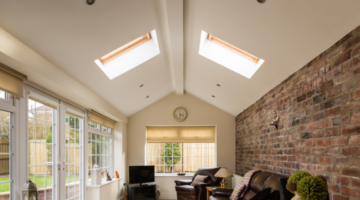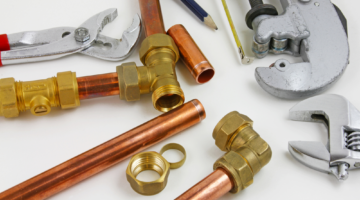
If you have been reading TheGreenAge blog for a while, you will know that we are pretty keen on infrared heating.
If you live in a home that doesn’t have access to mains gas, then unfortunately your heating choices are pretty limited, you can either go for a heat pump, storage heaters, electric convection heaters or the infrared heaters.
The reason infrared heaters are our preference is that they are affordable (a ground source heat pump for example can cost upwards of £20,000 which makes them too expensive for most) and they are also efficient.
The concept of infrared is that instead of heating the air like a traditional radiator (or storage heater), the infrared heaters heat solid objects directly. Once the infrared panels get to temperature, the units emit infrared radiation that travels unimpeded until it hits a solid object i.e. a person or some furniture. This object absorbs the infrared and then warms up.
The nice thing about infrared is that you are not wasting energy heating air that can easily escape up chimneys or through draughty windows. You are just heating the objects that require heating. Now considering you are heating surface area instead of volume you do get huge energy savings – but it is easy to say – what are the numbers that back up these huge savings?
Running costs of infrared versus electric convection heating
The savings from infrared all come due to the sizing of the system. Typically an infrared heater just 40% the size of a traditional convection radiator will produce the same level of comfort. So a 1kW convection heater will produce the same level of comfort for the occupant as a 400w infrared heating panel.
This is where the savings come from! Typically we recommend using between 50 watts and 100 watts per m2 depending on how well insulated a space is. A better insulated space will be closer to the 50w/m2 while an old uninsulated property will be nearer the 100w/m2.
So look at the table below to see the running costs – we have made the following assumptions:
- The heating is on for 5 hours per day.
- The cost of electricity is 12.5p / kWh
- We are using a 1kW electric convection heater (and therefore a 0.4kW infrared heater.
- There are 120 days in winter (approx. beginning of November till end of February)
| Infrared Heater | Electric Heating | |
|---|---|---|
| Wattage of heater (w) | 400w | 1200w |
| Total units used per hour (kWh) | 0.4kWh | 1.2kWh |
| Cost of running unit for 1 hour | £0.05 | £0.15 |
| Cost of running for 5 hours each day | £0.25 | £0.75 |
| Total running cost over winter period | £30.00 | £90.00 |
So in this simple example we are looking at a saving of £60 per year by installing infrared over a standard electric panels heating, but it is worth pointing out that this does not take into account the speed at which the heat is felt using infrared.
When an infrared heater is turned on, the panel will heat up and start producing the infrared within just a couple of minutes, it is then that the occupant will feel the warmth.
With an electric convection heater, the heater needs to get warm and then this needs to heat the air – it is only then, once the air gets up to temperature, that the occupant will feel the heat.
Bearing this in mind, the savings from the infrared heaters stated in the table are actually underestimated.
Comparing electric heating versus gas central heating
With gas costing just 3.5p/kWh, it is pretty clear to see that the cost of heating a home with gas is considerably cheaper than heating a home with electricity, but there is one important point to consider.

So while gas central heating is a great way to heat your home, the fact that you can zone your heating with electrical heating so easily (i.e. just heat rooms as and when required), the case for opting for gas over electric isn’t completely black and white.
So in conclusion, if you are going for electric heating and don’t have funds readily available to go for a heat pump, we would really recommend infrared heating as a means of heating your home or business. The running costs of infrared heating versus electric convection heating illustrate there are large savings to be had by making the swap to infrared.
The case for infrared over and above a gas central heating system is less compelling, but still the ability to only heat rooms as required and the low install and maintenance costs mean that infrared should not be discounted.
Alternatively, if you would like us to find you a local installer to help install infrared heating in your home, just fill in the form below and we will be in touch shortly!
Installing infrared heating
Are you thinking about installing infrared heating in your home? We have scoured the country for the best tradespeople, so that we can make sure we only recommend those we really trust.
If you would like us to find you a local installer to help install infrared heating in your home, just fill in the form below and we will be in touch shortly!













Hello,
My company has a night time cleaning crew that cleans buses at night. During the winter, the washbay that they work in gets pretty cold, as it is not heated, and the garage door is quite large and remains open to pull buses in and out all night.
I am planning to install some infrared heaters high along the interior of the wash bay to take the chill off of the cleaners as they work through the night.
My question is: in this type of application would it be cheaper to operate an electric or a propane infrared heating solution for this situation?
Thanks in advance!
-Heath
Propane black tube with stainless steel shroud as long as you don’t push the burner size depends on length of the Run too long of a run and the flue gas well condensate in the pipe waste oil furnace maybe an option that you’re overlooking
I can send you a testimonial from a big warehouse that wanted to heat a specific area of the warehouse only, and not the rest, so they put in our FAR-IR heaters. They were over the moon.
Anybody in the US?
We have just tried out a 400w infrared panel, the cost is 12 pence a minute, with the heating value to be ignored, the room tries out 3×3 sq.metre on increased by 0.5 degree over 5 hours. Hence, we think infrared is a very expense way to heat. We have also tried a halogen heater that came out on 17 pence a minute but the temp reached 20C within an hour when infrared just managed 19.5 over 5 hours.. Hence, the use was of the halogen heater 34 pence over 5 hours and the Infrared 60 pence over 5 hours without reaching the required temperature. The conclusion is obvious, do not use Infrared.
I am very confused, I was led to believe that an 400 watt IR heated cost about 6 pence to run?
Think you’ve got your numbers wrong here. 400W for 1 minute is 0.0067kWh (0.4 x (1/60)). Typical UK price of electricity per kWh is 14p. So 400W panel is 0.093 pence a minute.
A great bench mark, to help us all understand the test may I ask a few things. Height of ceiling and heat loss of the said area, as this will have quite an effect choosing the right amount of wattage required in that room and a guide to which heating system should be considered. We must keep in mind I.R heating does not heat the air, so what device was used to take the temperature and the comfort heating of IR next to heated air has been noted to be up to 2 degrees difference. When dealing with IR in a home environment one of the greatest savings can be made with the high speed reaction times, connecting to a smart controller can work miracles.
I am looking for infrared heating for a well insulated garden room measuring 5 m by 4 m by 2.3 m I want to attach the panel to the ceiling. Any advice welcome
All I will say is I have installed two panels in a home office exactly the same size, and had a wireless control fitted so I could control from my phone. I have no idea how much they are costing me to run, but it’s lovely and warm!
We have 7 panels in a Victorian property. They take ages to heat and cost a fortune to run as they need to be on all the time. The combined use is around 8.5 kw. The flat just isn’t warm in any event. We have replaced with two De’Longhi dragon oil filled radiators and a smaller oil filled radiator, and while still expensive they are around a third cheaper to run, manage the temperature and actually heat. Don’t believe the hype and marketing around these without real world examples. Unfortunately, gas central heating with a modern boiler is still the most cost effective and efficient heating system.
Infrared heaters aren’t really intended to heat a property. The purpose is to heat the occupants, and the area immediately around them. Kinda like invisible warm sunlight you can turn on in your immediate vicinity, it beams heat straight to you and you should turn it off when you’re not in the room.
dear Greenage
I think you need to update this page to reflect the 2022 cost of living crisis. I don’t know anyone who pays 12.5p per kwh. More like 30p.